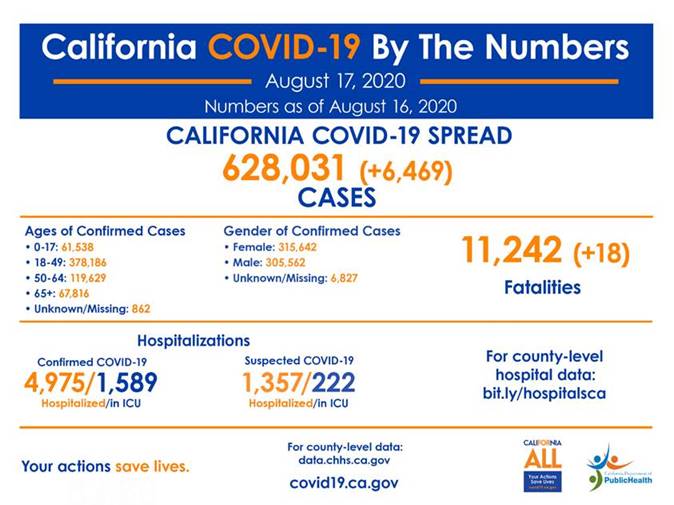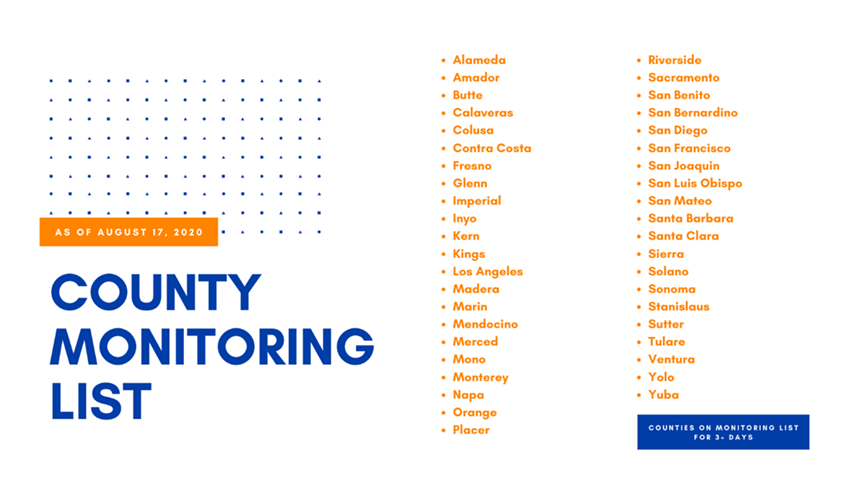SACRAMENTO – The California Department of Public Health (CDPH) today announced the most recent statistics on COVID-19.
- California has 628,031 confirmed cases to date. Numbers may not represent true day-over-day change as reporting of test results can be delayed.
- There were 6,469 newly recorded confirmed cases Sunday. Numbers do not represent true day-over-day change as these results include cases from prior to yesterday.
- The 7-day positivity rate is 7.1% and the 14-day positivity rate is 6.5%.
- There have been 9,933,780 tests conducted in California. This represents an increase of 135,645 over the prior 24-hour reporting period.
- As case numbers continue to rise in California, the total number of individuals who will have serious outcomes will also increase. There have been 11,242 COVID-19 deaths since the start of the pandemic.
- A total of 5 counties are newly required to close indoor operations for certain sectors based on the July 13 order to slow community transmission. These counties have until 11:59pm Wednesday August 19th to implement these closures.

County Data Monitoring Update
CDPH has updated the county data monitoring list now that the recent backlog of data has been cleared. As a result, CDPH has retroactively updated the list for each day over the entire period impacted (July 25 – August 16).
Counties that have now been added to the list include Amador, Calaveras, Inyo, Mendocino, and Sierra. Santa Cruz County has been removed from the list.
If a county should have moved off the list while the list was frozen, that date is being calculated retroactively. The calculation will use the first date after three consecutive days of being under the threshold for the county data monitoring metrics.
If a county moved onto the list during the period the list was frozen (August 1-16), to implement sector closures in compliance with the July 13 order, new closures must be effective by 11:59 pm on August 19.
Counties on the County Monitoring List for three or more consecutive days – currently 42 counties accounting for the majority of the state’s population – must have closed indoor operations for additional activities. The July 13 order specifies that these indoor operations shall remain closed, even when a county is removed from the county monitoring list, until the state health officer modifies the order and authorizes re-opening. The state is actively reassessing the July 13 order in light of evolving scientific evidence regarding disease transmission and the risk of transmission in different settings and will provide updates in the coming week.

For more information, visit the County Data Monitoring webpage.
Data and Tools
A wide range of data and analysis guides California’s response to COVID-19. The state is making the data and its analytical tools available to researchers, scientists and the public at covid19.ca.gov.
Popular links include:
- The Statewide COVID-19 Dashboard
- The California COVID-19 Assessment Tool (CalCAT)
- State Cases and Deaths Associated with COVID-19 by Age Group
- COVID-19 Race & Ethnicity Data
- COVID-19 Hospital Data and Case Statistics
- View additional datasets at the California Open Data Portal (Including: Testing Data, PPE Logistics Data, Hospital Data, Homeless Impact and more)
Multisystem Inflammatory Syndrome in Children (MIS-C)
Each week, the California Department of Public Health updates the number of cases of Multisystem Inflammatory Syndrome in Children (MIS-C) reported in the state. As of August 11, 36 cases of MIS-C have been reported statewide. To protect patient confidentiality in counties with fewer than 11 cases, we are not providing total counts at this time.
MIS-C is a rare inflammatory condition associated with COVID-19 that can damage multiple organ systems. MIS-C can require hospitalization and be life threatening. Parents should be aware of the signs and symptoms of MIS-C including fever that does not go away, abdominal pain, vomiting, diarrhea, neck pain, rash, bloodshot eyes or feeling tired. Contact your child’s doctor immediately if your child has these symptoms. Early diagnosis and treatment of patients is critical to preventing long-term complications.
Racial Demographics – A More Complete Picture
The California Department of Public Health is committed to health equity and collecting more detailed racial and ethnic data that will provide additional understanding for determining future action. Health outcomes are affected by forces including structural racism, poverty and the disproportionate prevalence of underlying conditions such as asthma and heart disease among Latinos and African American Californians. Only by looking at the full picture can we understand how to ensure the best outcomes for all Californians.
The differences in health outcomes related to COVID-19 are most stark in COVID-19 deaths. We have nearly complete data on race and ethnicity for COVID-19 deaths, and we are seeing the following trends: Latinos, African Americans, Native Hawaiians and Pacific Islanders are dying at disproportionately higher levels. More males are dying from COVID-19 than females, in line with national trends. More information is available at COVID-19 Race and Ethnicity Data.
Health Care Worker Infection Rates
As of August 16, local health departments have reported 28,610 confirmed positive cases in health care workers and 143 deaths statewide.
Your Actions Save Lives
Every person has a role to play. Protecting yourself and your family comes down to common sense:
- Staying home except for essential needs/activities following local and state public health guidelines when patronizing approved businesses. To the extent that such sectors are re-opened, Californians may leave their homes to work at, patronize, or otherwise engage with those businesses, establishments or activities.
- Practicing social distancing.
- Wearing a cloth face mask when out in public.
- Washing hands with soap and water for a minimum of 20 seconds.
- Avoiding touching eyes, nose or mouth with unwashed hands.
- Covering a cough or sneeze with your sleeve, or disposable tissue. Wash your hands afterward.
- Avoiding close contact with people who are sick.
- Staying away from work, school or other people if you become sick with respiratory symptoms like fever and cough.
- Answer the call if a contact tracer from the CA COVID Team or your local health department tries to connect. Contact tracers will connect you to free, confidential testing and other resources, if needed.
- Following guidance from public health officials.
What to Do if You Think You’re Sick
Call ahead: If you are experiencing symptoms of COVID-19 (for example: fever, cough, shortness of breath, fatigue, muscle or body aches), call your health care provider before seeking medical care so that appropriate precautions can be taken. More than 100 community testing sites also offer free, confidential testing: Find a COVID-19 Testing Site.
For more information about what Californians can do to prevent the spread of COVID-19, visit covid19.ca.gov.
California continues to issue guidance on preparing and protecting California from COVID-19. Consolidated guidance is available on the California Department of Public Health’s Guidance web page.

